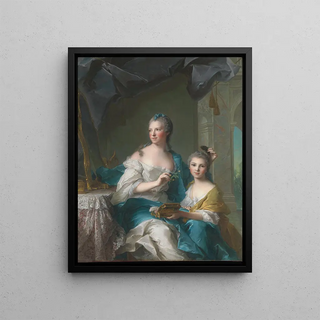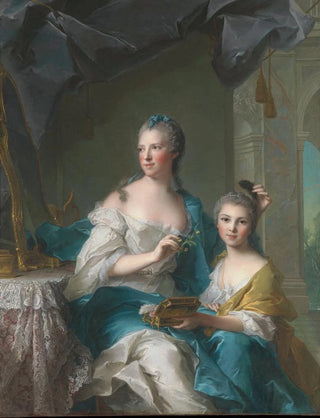Art print | Madame Marsollier and her daughter - Jean-Marc Nattier


View from behind

Frame (optional)
In the fascinating world of 18th-century French painting, "Madame Marsollier and her daughter" by Jean-Marc Nattier stands out for its elegance and delicacy. This artwork, created in 1750, embodies the refinement of the Rococo period, a time when art intertwined with daily life with a palpable lightness and sensuality. Nattier, known for his portraits of women, succeeds here in capturing not only the physical appearance of his subjects but also their spiritual essence. The painting invites the viewer to immerse themselves in an intimate moment between mother and daughter, where love and tenderness are evident in their gazes and gestures. This delicate and emotive representation makes this piece a true masterpiece, demonstrating the artist's mastery in the art of portraiture.
Style and uniqueness of the work
Nattier's style is characterized by a subtle use of light and color, creating a soft and dreamlike atmosphere. In "Madame Marsollier and her daughter," pastel shades, flowing drapery, and meticulous costume details evoke timeless elegance. The composition is carefully orchestrated: Madame Marsollier, dressed in an elegant gown, is positioned at the center, while her daughter, in a delicate pose, seems to emerge from a world of softness. The expressions of the two women, imbued with serenity and complicity, reveal the intimacy of a strong family bond. Nattier manages to transcend the simple portrait to offer a poetic vision of motherhood and femininity, making this work highly modern for its time.
The artist and his influence
Jean-Marc Nattier, born in 1685, is often regarded as one of the most influential portraitists of his era. He established himself in the Parisian artistic scene thanks to his exceptional talent and his ability to capture the personality of his models. His innovative approach to portraiture, blending realism and idealization, inspired many artists of his time and subsequent generations. Nattier was also a pioneer in the representation of women in art.

Matte finish

View from behind

Frame (optional)
In the fascinating world of 18th-century French painting, "Madame Marsollier and her daughter" by Jean-Marc Nattier stands out for its elegance and delicacy. This artwork, created in 1750, embodies the refinement of the Rococo period, a time when art intertwined with daily life with a palpable lightness and sensuality. Nattier, known for his portraits of women, succeeds here in capturing not only the physical appearance of his subjects but also their spiritual essence. The painting invites the viewer to immerse themselves in an intimate moment between mother and daughter, where love and tenderness are evident in their gazes and gestures. This delicate and emotive representation makes this piece a true masterpiece, demonstrating the artist's mastery in the art of portraiture.
Style and uniqueness of the work
Nattier's style is characterized by a subtle use of light and color, creating a soft and dreamlike atmosphere. In "Madame Marsollier and her daughter," pastel shades, flowing drapery, and meticulous costume details evoke timeless elegance. The composition is carefully orchestrated: Madame Marsollier, dressed in an elegant gown, is positioned at the center, while her daughter, in a delicate pose, seems to emerge from a world of softness. The expressions of the two women, imbued with serenity and complicity, reveal the intimacy of a strong family bond. Nattier manages to transcend the simple portrait to offer a poetic vision of motherhood and femininity, making this work highly modern for its time.
The artist and his influence
Jean-Marc Nattier, born in 1685, is often regarded as one of the most influential portraitists of his era. He established himself in the Parisian artistic scene thanks to his exceptional talent and his ability to capture the personality of his models. His innovative approach to portraiture, blending realism and idealization, inspired many artists of his time and subsequent generations. Nattier was also a pioneer in the representation of women in art.






